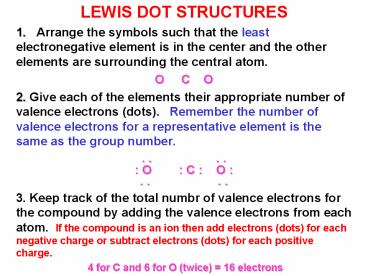LEWIS DOT STRUCTURES - PowerPoint PPT Presentation
Title:
LEWIS DOT STRUCTURES
Description:
LEWIS DOT STRUCTURES 1. Arrange the symbols such that the least electronegative element is in the center and the other elements are surrounding the central atom. – PowerPoint PPT presentation
Number of Views:167
Avg rating:3.0/5.0
Title: LEWIS DOT STRUCTURES
1
- LEWIS DOT STRUCTURES
- 1. Arrange the symbols such that the least
electronegative element is in the center and the
other elements are surrounding the central atom. - O C O
- 2. Give each of the elements their appropriate
number of valence electrons (dots). Remember
the number of valence electrons for a
representative element is the same as the group
number. - . . . .
- O C O
- . . . .
- 3. Keep track of the total numbr of valence
electrons for the compound by adding the valence
electrons from each atom. If the compound is an
ion then add electrons (dots) for each negative
charge or subtract electrons (dots) for each
positive charge. - 4 for C and 6 for O (twice) 16 electrons
2
- LEWIS DOT STRUCTURES
- 4. Now move the dots around so that you have 8
dots (the octet rule) around each element (do not
forget the exceptions) while at the same time
keeping the dots in pairs. Electrons, at this
point, exist as pairs (the buddy system). - 5. EXCEPTIONS TO THE OCTET RULE Group I, II, and
III need only 2, 4, and 6 electrons,
respectively, around that atom. - 6. If there are too few pairs to give each atom
eight electrons, change the single bonds between
two atoms to either double or triple bonds by
moving the unbonded pairs of electrons next to a
bonding pair. - . . . .
- O C O
3
- LEWIS DOT STRUCTURES
- 7. Once the octet rule has been satisfied for
each atom in the molecule then you may replace
each pair of dots between two atoms with a dash. - . . . .
- O C O
- 8. Now check your structure by
- a) count the total number of electrons to
make sure you did not lose or gain electrons
during the process. - b) Use FORMAL CHARGE (FC) calculations as a
guideline to the correct structure. A zero
formal charge is usually a good indication of a
stable structure. - FC (X) of valence electrons - (1/2 bonding
electrons nonbonding electrons) - For our example FC(C) 4 - (1/2 8 0) 0
- FC(O) 6 - (1/2 4 4) 0
4
- LEWIS DOT STRUCTURES
- Predict the most stable structure ONC- or OCN-
or NOC- - . . .. . .
.. .. .. - ONC or OCN or
NOC - 1) Total electrons is
- 6 e- for O 5 e- for N 4 e- for C 1 e- for
negative charge 16 e- total. All structures
fulfill the octet rule. - 2) FC (X) of valence electrons - (1/2
bonding electrons nonbonding electrons) - structure1 structure 3
- FC(C) 4 - (1/2 4 4) -2 FC(C) 4 - (1/2 4
4) -2 - FC(O) 6 - (1/2 4 4) 0 FC(O) 6 - (1/2 8
0) 2 - FC(N) 5 -(1/2 8 0) 1 FC(N) 5 -(1/2 4
4) -1 - structure2
- FC(C) 4 - (1/2 8 0) 0
- FC(O) 6 - (1/2 4 4) 0
- FC(N) 5 -(1/2 4 4) -1
structure 2 has the combination with the lowest
formal charge. It also has the negative formal
charge on one of the more electronegative atoms.
Calculate the formal charge for the most stable
structure . .
OCN . .
(-1, 0, 0)
5
- Draw the Lewis Structure for the following
molecules. - 1. H2O
- Oxygen has 6 valence electrons Hydrogen has 1
valence electron for a total of 8 electrons. - . .
- H O H
- . .
- 2. CO
- Oxygen has 6 valence electrons Carbon has 4
valence electrons for a total of 10 electrons. - C O
6
- Draw the Lewis Structure for the following
molecules. - 3. BH3
- Boron has 3 valence electrons Hydrogen has 1
valence electron for a total of 6 electrons - H B H
- . .
- H
- 4. NH3
- Nitrogen has 5 valence electrons Hydrogen has
1 valence electron for a total of 8 electrons - . .
- H N H
- . .
- H
7
Practice Problem 13
- ClO2- SiH4
- AsH3
.. .. .. O Cl O .. ..
..
H H Si H
H
.. H As H H
8
Group Study Problem 13
- 1. Draw the Lewis structure for the following
- a) H2S b) PH3 c) CH2O
- d) NO2- e) GaH3 f) CBr4
- g) CH2FCl h) C2H2 I) O3
- 2. Calculate the formal charge for c, d,
f, and I.































